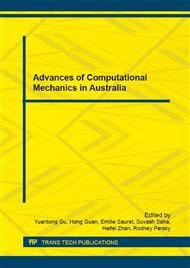[1]
I. Solodov, D. Döring, and G. Busse, New opportunities for NDT using non-linear interaction of elastic waves with defects, Strojniški vestnik-Journal of Mechanical Engineering, vol. 57, pp.169-182, (2011).
DOI: 10.5545/sv-jme.2010.168
Google Scholar
[2]
C. H. Wang, J. T. Rose, and F. -K. Chang, A synthetic time-reversal imaging method for structural health monitoring, Smart materials and structures, vol. 13, p.415, (2004).
DOI: 10.1088/0964-1726/13/2/020
Google Scholar
[3]
E. Chan, L. R. F. Rose, and C. H. Wang, An extended diffraction tomography method for quantifying structural damage using numerical Green's functions, Ultrasonics, vol. 59, pp.1-13, 5/ (2015).
DOI: 10.1016/j.ultras.2015.01.001
Google Scholar
[4]
E. Chan, C. H. Wang, and F. L. R. Rose, Characterisation of Laminar Damage in an Aluminium Panel by Diffraction Tomography Based Imaging Method Using Lamb Waves, ed, (2014).
Google Scholar
[5]
L. R. F. Rose, E. Chan, and C. H. Wang, A comparison and extensions of algorithms for quantitative imaging of laminar damage in plates. II. Non-monopole scattering and noise tolerance, p.32, 15 July 2015 (2015).
DOI: 10.1016/j.wavemoti.2016.04.004
Google Scholar
[6]
L. Baillet and T. Sassi, Mixed finite element methods for the Signorini problem with friction, Numerical Methods for Partial Differential Equations, vol. 22, pp.1489-1508.
DOI: 10.1002/num.20147
Google Scholar
[7]
K. J. Nicholson and C. H. Wang, Improved Near-Field Radar Cross-Section Measurement Technique, Antennas and Wireless Propagation Letters, IEEE, vol. 8, pp.1103-1106.
DOI: 10.1109/lawp.2009.2033951
Google Scholar
[8]
E. Chan, F. Rose, and C. Wang, Multi-frequency Approach to Imaging Damage in Stiffened Structures Exhibiting Multi-Path Reflections, p.8, May 15 2015 (2015).
DOI: 10.12783/shm2015/239
Google Scholar
[9]
C. H. Wang and L. Rose, Minimum Sensor Density for Quantitative Damage Imaging, in 9th International Workshop on Structural Health Monitoring, (2013).
Google Scholar
[10]
C. H. Wang and L. Francis Rose, Imaging damage using mixed passive and active sensors, in Key Engineering Materials, 2013, pp.244-251.
DOI: 10.4028/www.scientific.net/kem.558.244
Google Scholar
[11]
V. Giurgiutiu, Structural health monitoring: with piezoelectric wafer active sensors: Academic Press, (2007).
Google Scholar
[12]
N. C. Yoder and D. Adams, Vibro-Acoustic Modulation Utilizing a Swept Probing Signal for Robust Crack Detection, Struct. Health Monit., vol. 9, pp.257-267.
DOI: 10.1177/1475921710365261
Google Scholar


